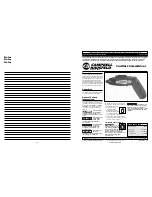
GMC-I Messtechnik GmbH
49
5.2 Auto-Sensing Mode
In order to be able to take advantage of highly constant output
voltage at the power consumer even if long leads are used,
sensing leads can be used to compensate for voltage drops
within the output leads.
Functions
Sensing lead terminals
+SENSE and –SENSE
Acquirement of output voltage, which decisively influences the
voltage measuring and control circuits,
directly at the power
consumer
(instead of at the output terminals).
Sensing mode operation (
remote sensing
) offers the following
advantages:
-
In the
constant voltage regulating mode
,
current related
voltage
drops
occurring in the
output leads
have practically
no effect
on
voltage
supplied to the power consumer.
-
Voltage at the output terminals is automatically increased to
compensate
for voltage drops.
-
In the
constant current regulating mode
,
voltage limiting
at the
consumer is
independent
of
output current
.
-
The
voltage value
read out by the measuring function
indicates
voltage acquired at the sensing leads
.
Load parameters
such as
power consumption
and
load resistance
can thus be
determined more accurately.
The
parameters
and
limit values
included in figure
in figure
5.2
and in the section entitled
Electrical Data
apply for operation
with the sensing leads.
Figure 5.2
Connecting the Power Consumer for
Sensing Mode Operation
C
s+
, C
s-
10
F ... 220
F
U
s+
,U
s-
1 V
I
s+
U
s+
/ 81
I
s-
U
s-
/ 81
Connection
The
+SENSE
and
–
SENSE
sensing leads from the output
connector plug at the rear panel should be connected
as close
as possible
to the power consumer.
Connect each respective
sensing lead
to the appropriate
output
pole
(
+SENSE
:
+, –
SENSE:
–
)
.
Interference
can be minimized by:
-
Twisting
the sensing leads and/or
-
Shielding
the sensing leads (connect shield to ground, the
housing or the negative output pole)
Long
output and sensing lead impedances
may result in control
fluctuations at the output.
This problem is of course worsened by
capacitive consumers
.
Control fluctuations can be counteracted with one capacitor
each (
C
s+
, C
s-
) between the
SENSE
and
output terminals
(see
Figure 5.2).
If the
output leads are twisted
, their impedance can be reduced
as well.
Incorrect connection of the sensing leads does not damage the
KONSTANTER
, although it results in the following reversible events:
-
Polarity reversal at sensing leads or interrupted output lead
If output voltage is not being limited at the KONSTANTER by
means of current regulation, it climbs to well above the
selected value.
This condition immediately triggers overvoltage protection
and deactivates the output.
-
Interruption of a sensing lead
Automatic reset to local sensing for the respective output
pole.
If the sensing leads have been connected incorrectly,
increasing voltage between the output terminals is not
acquired by the measuring function.
Activation
The remote sensing mode function is activated
automatically
after
the SENSE terminals have been connected to the power
consumer at the respective output poles.
The function is deactivated by once again
interrupting
this
connection.
5.3 Status Signal Outputs
Functions
The KONSTANTER is equipped with two open collector
outputs with reference to AGND for reading out status signals,
namely
SIG1OUT
and
SIG2OUT.
The device status or event to be signaled is independent for
both signal outputs.
Selection is made by setting the SIG1 and SIG2 functions.
A detailed description is included on page 29 for manual
operation, and on page 71 for programming.
As a
status signal
for monitoring devices
For
controlling
external
output relays
Applications
Triggering of certain device functions can be synchronized by
means of connection to the trigger inputs of other
KONSTANTERs (see also chapter 5.9.2).
Connection
Values for connection:
Max. switching voltage: 30 V DC
Max. switching current: 20 mA
If you want to use the signal outputs to send
status signals
to
external monitoring devices,
pull-up resistors
must be used in
order to generate appropriate levels.
The status signal outputs can be connected to the +15 V
terminal with pull-up resistors (at least 1 k
), in order to
generate an active high signal of +15 V.
SSP KONSTANTER
Settings
USET = Uset
ISET = Iset
+ SENSE
OUT
OUT
SENSE
Analog Interface
SIG1 OUT
SIG2 OUT
TRG IN
TRG IN
+15 V
AGND
Uset
Uset +
Iset +
U-MON
I-MON
+ OUT
+ OUT
Uout
Load
Iout
Output
R
PU
OUTPUT ON
+5 V
Usig
Figure 5.3
Wiring Examples for
Status Signal Outputs
Содержание SSP 120 Series
Страница 2: ...2 GMC I Messtechnik GmbH ...
















































